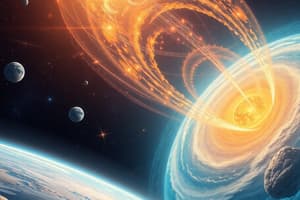Podcast
Questions and Answers
What type of output is required to accompany the picture in the activity?
What type of output is required to accompany the picture in the activity?
- A creative title and reflection paper. (correct)
- A digital album of related pictures.
- A report summarizing environmental science.
- A verbal presentation about the photo.
Why is it important to preserve the uniqueness of the planet as indicated in the activity?
Why is it important to preserve the uniqueness of the planet as indicated in the activity?
- To enable urban development more efficiently.
- To promote biodiversity and sustainability. (correct)
- To ensure Earth remains unchanged.
- To attract more tourists to natural sites.
Which score category indicates that the content and main ideas of the expected output are unclear or lacking?
Which score category indicates that the content and main ideas of the expected output are unclear or lacking?
- Category 3
- Category 4
- Category 2
- Category 1 (correct)
In terms of supporting details for the output, what is emphasized in the grading rubric?
In terms of supporting details for the output, what is emphasized in the grading rubric?
What is the maximum limit for the reflection paper in terms of length?
What is the maximum limit for the reflection paper in terms of length?
What is the significance of Earth's position in the solar system?
What is the significance of Earth's position in the solar system?
Which of the following factors contributes to Earth's habitability?
Which of the following factors contributes to Earth's habitability?
What primary component of Earth's core contributes to its strong magnetic field?
What primary component of Earth's core contributes to its strong magnetic field?
Which planets are considered terrestrial planets along with Earth?
Which planets are considered terrestrial planets along with Earth?
What do all terrestrial planets have in common?
What do all terrestrial planets have in common?
What is a major difference between Earth and Venus?
What is a major difference between Earth and Venus?
Which category is not listed as a requirement for making Earth habitable?
Which category is not listed as a requirement for making Earth habitable?
How does Earth's atmosphere contribute to its unique environment?
How does Earth's atmosphere contribute to its unique environment?
How old is the Earth according to the provided information?
How old is the Earth according to the provided information?
What shape is Earth described as in the context provided?
What shape is Earth described as in the context provided?
What caused the different materials to shift to Earth's core during its formation?
What caused the different materials to shift to Earth's core during its formation?
What led to the creation of landforms like mountains and volcanoes?
What led to the creation of landforms like mountains and volcanoes?
Which hypothesis describes the origin of Earth?
Which hypothesis describes the origin of Earth?
Why is Earth considered to be in a special position in the context of water?
Why is Earth considered to be in a special position in the context of water?
What role did electrical storms play in Earth's early atmosphere?
What role did electrical storms play in Earth's early atmosphere?
Flashcards are hidden until you start studying
Study Notes
Introduction to Earth and Life Science
- Welcome by Ms. Jean Cyra M. Laloma, Earth and Life Science class.
- Contact via email: jmlaloma@firstasia.edu.ph.
Universe and Solar System Recap
- Questions to reflect upon regarding the video's content and significance of understanding the universe.
- Opportunity for personal reflection on potential space travel destinations.
The Beginnings of Earth
- Earth is unique as the only known planet that sustains life.
- Objectives include identifying Earth’s characteristics, explaining its formation, and recognizing planetary uniqueness.
Earth’s Profile
- Position: Third planet from the sun; classified as an oblate spheroid.
- Age: Approximately 4.5 billion years old.
- Origin: Formed from a nebular hypothesis with an initially hot gaseous mass.
- Core Composition: Contains molten nickel and iron, contributing to a protective magnetic field.
Unique Features of Earth
- Earth's atmosphere and magnetic field protect against harmful solar radiation, designating it as the "living planet."
- The planet is located in the “Goldilocks Zone,” where conditions support life.
Conditions for Habitability
- Temperature: Ranges between -15°C to 115°C allows for liquid water stability.
- Energy: Availability of light or chemical energy supports vital chemical reactions.
- Atmosphere: Provides warmth and protection from radiation and meteorites.
- Nutrients: Solid planets and moons share chemical compositions as a source of nutrients.
Comparison of Terrestrial Planets
-
Similarities among Earth, Venus, and Mars:
- Solid rocky structures and silicate compositions.
- All have atmospheres and recognizable landforms.
- Similar axial rotation times.
- Presence of carbon dioxide.
-
Differences:
- Venus lacks water, while Earth and Mars possess it.
- Venus and Mars do not support oxygen, whereas Earth does.
- Earth is the only planet among them with known life forms.
Reflective Questions
- Consider personal unique characteristics that align with Earth's uniqueness.
- Examine actions that can be taken to preserve Earth's distinctiveness.
Home-Based Activity: "Earthsploration"
- Capture unique Earth characteristics through photography around one's home or use recent nature photos.
- Engage in creative writing to reflect on uniqueness shared with Earth and steps for preservation.
- Submission requirements include a printed picture and a handwritten reflection limited to two paragraphs.
Assessment Criteria for Activity
- Content assessment focuses on clarity and understanding of main ideas in visual outputs.
- Supporting details evaluated on relevance and presence of clarity versus distracting elements.
Studying That Suits You
Use AI to generate personalized quizzes and flashcards to suit your learning preferences.




